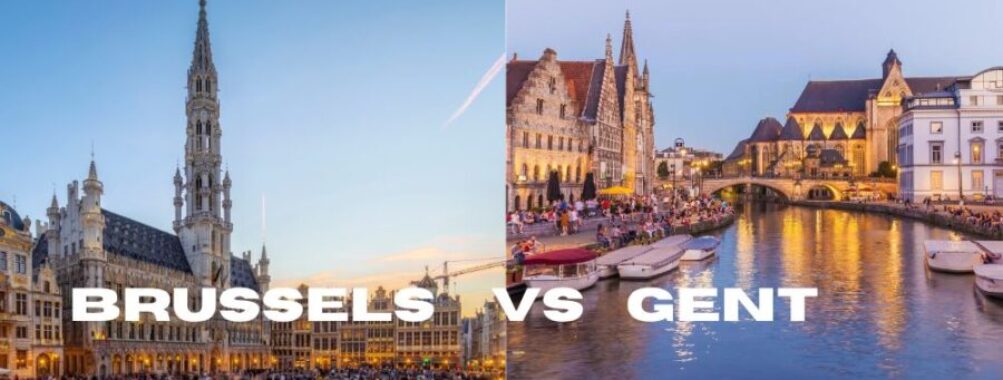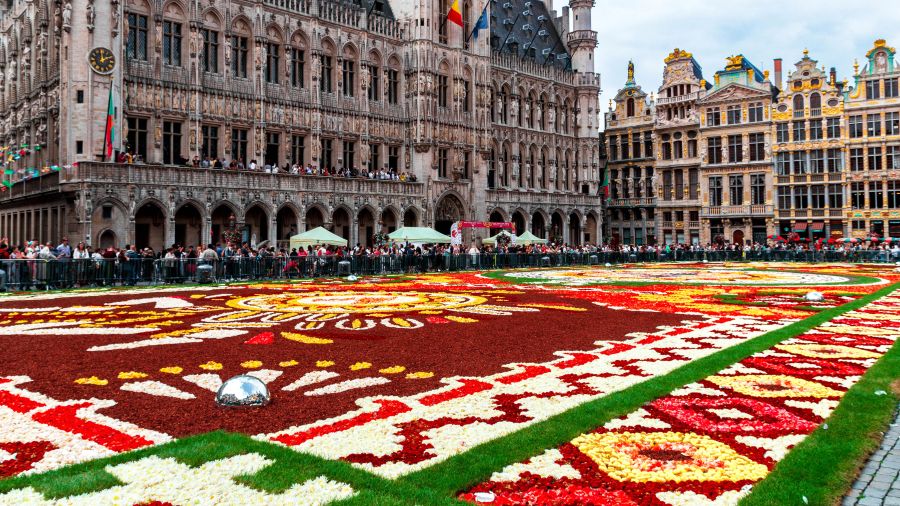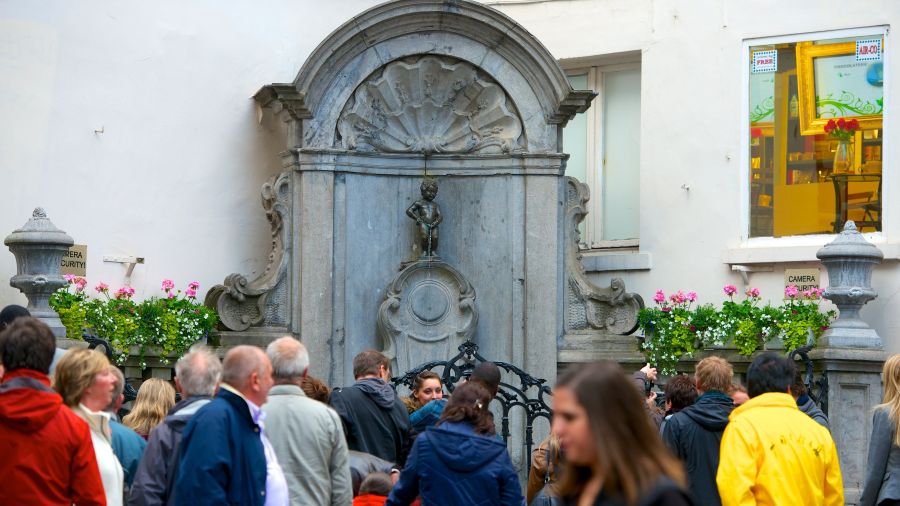
Brussels vs Gent: Battle of Belgium’s Most Charming Cities Revealed (2025 Guide)
Brussels and Ghent stand as two of Belgium’s most captivating cities, each with its own unique charm. These medieval gems draw visitors from around the world, making it tough to pick between them for a Belgian adventure.
Most travelers will find Ghent the better choice. It offers a perfect mix of preserved medieval architecture, student-driven nightlife, and fewer tourist crowds than Brussels. The city’s manageable size makes it easy to explore on foot, while its central location provides quick access to other Belgian destinations.
The cobblestone streets of Ghent tell stories of the past while buzzing with modern energy. Its canals reflect centuries-old guild houses and churches, creating picture-perfect scenes at every turn. Unlike Brussels’ more modern, business-focused atmosphere, Ghent maintains its authentic Belgian character while embracing innovations in food, art, and culture.
Contents
- Historical Overview and Significance
- Brussels at a Glance
- Ghent’s Historical Context
- Cultural Highlights
- Brussels’ Multifaceted Culture
- Ghent’s Cultural Mosaic
- Architectural Styles and Landmarks
- Brussels’ Architectural Tapestry
- Ghent’s Architectural Heritage
- Leisure and Activities
- Exploring Brussels’ Activities
- Experiencing Ghent’s Activities
- Culinary Journey
- Savoring Brussels’ Gastronomy
- Ghent’s Culinary Delights
- Accommodation and Lodging
- Hotels in Brussels
- Staying in Ghent
- Travel Practicalities
- Navigating Brussels
- Getting Around Ghent
- Day Trips and Excursions
- Day Trips from Brussels
- Day Trips from Ghent
- Frequently Asked Questions
- What distinct experiences do Brussels and Ghent offer to visitors?
- How does the cost of living compare between Ghent and Brussels?
- Which city has a richer cultural and historical offering, Brussels or Ghent?
- What are the travel considerations when choosing between visiting Ghent or Brussels?
- How do the local cuisines in Ghent differ from those in Brussels, and what are the must-try dishes?
- How does Ghent’s nightlife and entertainment compare to Brussels?
- More Travel Guides
Historical Overview and Significance
Brussels and Ghent stand as two of Belgium’s most fascinating cities, each with deep roots stretching back through medieval times to the present day. Their histories have shaped Belgium’s cultural landscape in distinct ways.
Brussels at a Glance

Brussels grew from a small 10th-century fortress town into Belgium’s mighty capital. The Grand Place, a UNESCO World Heritage site, showcases the city’s golden age as a merchant hub during the 1400s. The stunning gothic Town Hall towers over the square as a symbol of medieval power.
Trade and politics transformed Brussels into a major European center. The city gained prominence in the 15th century under the Burgundian dukes. Its role expanded when it became the capital of the Spanish Netherlands in the 16th century.
The city really took off after Belgium’s independence in 1830. Kings Leopold I and II shaped Brussels into a showcase capital with grand boulevards and parks. Today’s Brussels serves as the heart of the European Union.
Ghent’s Historical Context

Ghent emerged at the meeting point of two rivers – the Lys and the Scheldt. The city began in 630 when Saint Amandus built an abbey at this strategic location. By the Middle Ages, Ghent had become one of Europe’s largest cities.
The textile trade brought massive wealth to medieval Ghent. Its powerful guilds built impressive monuments like the Gravensteen castle and Saint Bavo’s Cathedral. These landmarks still define the city’s skyline.
Ghent played a key role in European history. The Treaty of Ghent ended the War of 1812 between Britain and America. The city’s medieval core survived both World Wars mostly intact, preserving its authentic historic character.
Cultural Highlights
Both Brussels and Ghent offer distinct cultural experiences shaped by their unique histories and modern influences. These cities showcase Belgian heritage through art, festivals, and culinary traditions.
Brussels’ Multifaceted Culture

Brussels buzzes with cultural diversity as the European Union’s capital. The city’s museums feature world-class collections, from ancient art to modern exhibitions.
The Grand Place comes alive with festivals and events throughout the year. The Flower Carpet in August transforms the square into a stunning display of begonias.
Food culture thrives in Brussels’ neighborhoods. You’ll find traditional Belgian fries stands next to Michelin-starred restaurants. The city’s chocolate shops and craft beer bars keep old traditions alive while embracing new trends.
Street art adds color to various districts. Artists have turned building walls into massive canvases, especially in the Marolles quarter.
Ghent’s Cultural Mosaic

Ghent’s cultural scene blends medieval charm with modern creativity. The city hosts the largest cultural festival in Belgium – the Gentse Feesten, drawing thousands each July.
Students bring energy to Ghent’s arts scene. Local bands perform in converted warehouses, while art galleries showcase emerging talent.
The city takes pride in its craft beer culture. Many bars serve local brews alongside traditional Trappist beers. The Gruut Brewery uses medieval recipes with a modern twist.
Historic buildings house contemporary arts centers. The SMAK museum features cutting-edge exhibitions in a former casino building.
Theater and music thrive in Ghent’s restored venues. The Opera House and Vooruit arts center host performances ranging from classical to experimental.
Architectural Styles and Landmarks
Brussels and Ghent showcase very different architectural personalities. Brussels mixes grand European styles from many periods, while Ghent keeps its medieval charm alive through preserved Gothic buildings and a castle.
Brussels’ Architectural Tapestry

The streets of Brussels display an amazing mix of architectural styles. Gothic masterpieces like the Grand Place stand next to elegant Art Nouveau buildings designed by Victor Horta.
The city’s Art Deco influence shows up in many spots, with striking geometric patterns and decorative details on building facades. You’ll spot this style as you walk through neighborhoods like Saint-Gilles.
The European Quarter brings modern glass-and-steel buildings into the mix. This area houses the European Parliament and other EU institutions.
The Gothic Town Hall remains one of Brussels’ most eye-catching landmarks. Its 96-meter spire towers over the Grand Place, making it impossible to miss.
Ghent’s Architectural Heritage

Medieval architecture rules in Ghent. The city’s skyline features the famous “Three Towers” – Saint Nicholas’ Church, the Belfry, and Saint Bavo’s Cathedral.
The Gravensteen Castle stands as Ghent’s most impressive landmark. This 12th-century fortress looks like it jumped straight out of a fairy tale, complete with turrets and a moat.
The STAM City Museum shows off Ghent’s architectural evolution. It combines a 14th-century abbey with a 17th-century convent and modern additions.
The historic center features well-preserved guild houses along the Graslei and Korenlei waterfronts. Their step-gabled facades reflect in the river, creating picture-perfect views.
Leisure and Activities
Both Belgian cities offer distinct entertainment scenes and cultural activities that cater to different tastes and interests. Brussels shines with its grand entertainment venues and diverse nightlife, while Ghent captivates visitors with its youthful energy and artistic spaces.
Exploring Brussels’ Activities

Brussels boasts an active cultural scene centered around the Grand Place. The city comes alive at night with countless bars and nightlife activities in the Saint-Géry and Saint-Jacques neighborhoods.
The city features many music venues hosting live performances throughout the week. Jazz clubs and concert halls dot the downtown area, creating a vibrant atmosphere for music lovers.
Art galleries and museums stay open late on specific evenings. The Comic Strip Center celebrates Belgium’s rich comic book heritage with rotating exhibitions and workshops.
Street performances and outdoor festivals fill the squares during warmer months. Food trucks and pop-up markets create gathering spots for locals and tourists alike.
Experiencing Ghent’s Activities

Ghent’s student population drives its creative and alternative scene. The city’s historic center transforms after dark with cozy bars and music venues tucked into medieval buildings.
The Patershol neighborhood draws crowds with its trendy restaurants and art spaces. Local breweries offer tasting tours where visitors can sample authentic Belgian beers.
Cultural activities thrive along the Graslei waterfront. Street artists and performers entertain passersby while cafes provide perfect viewing spots.
The Design Museum and SMAK contemporary art museum anchor Ghent’s artistic offerings. Regular exhibitions showcase both established and emerging artists.
The city hosts numerous festivals celebrating music, film, and theater throughout the year. Many events take place in historic venues, blending old and new cultural experiences.
Culinary Journey
Belgium’s two vibrant cities offer distinct food experiences that showcase rich traditions and innovative cooking styles. Each destination brings its own flavors and specialties to the table.
Savoring Brussels’ Gastronomy

Brussels treats food lovers to world-famous Belgian chocolate shops along Rue Royale and Place du Grand Sablon. Master chocolatiers craft pralines and truffles right before your eyes.
The city’s street food scene centers around crispy frites served in paper cones with dozens of sauce choices. You’ll spot locals grabbing these at friteries throughout the city squares.
Traditional Belgian restaurants around Grand Place serve hearty classics like carbonnade flamande (beef stew) and moules-frites (mussels with fries). The area features cozy brown cafés where you can sample hundreds of Belgian beers.
Ghent’s Culinary Delights

Ghent puts a creative spin on Belgian cuisine with its mix of traditional and modern eateries. The city’s signature dish is waterzooi – a creamy stew made with chicken or fish.
The Patershol neighborhood houses intimate restaurants in medieval buildings. Local chefs transform fresh Flemish ingredients into innovative dishes that honor old recipes while adding contemporary flair.
Food markets bring extra flavor to Ghent’s streets. The Korenmarkt hosts vendors selling regional cheeses, cured meats, and fresh produce. Don’t miss trying cuberdon candies – cone-shaped purple sweets that locals call “little noses.”
Plant-based dining thrives here too. Ghent has more vegetarian restaurants per capita than most European cities, earning its nickname as the veggie capital of Europe.
Accommodation and Lodging
Brussels and Ghent each offer unique lodging options that fit different travel styles and budgets. The medieval charm of Ghent contrasts with the metropolitan vibe of Brussels, reflected in their distinct accommodation choices.
Hotels in Brussels

Book accommodations in Brussels at prices ranging from €80 to €300 per night. The city center near Grand Place houses many luxury hotels and boutique properties.
The best hotels cluster around the historic center and European Quarter. Many international chains maintain a presence here, offering reliable service and modern amenities.
Business travelers often prefer stays near the EU institutions, while tourists gravitate toward accommodations close to Grand Place and Central Station.
Room rates tend to spike during major EU events and conferences. Booking well in advance can secure better deals, especially during peak season from June to August.
Staying in Ghent

Ghent’s accommodation scene features more intimate B&Bs and boutique hotels, giving travelers a cozier, more local experience. Prices typically run from €70 to €200 per night.
The historic center near Gravensteen Castle offers charming converted merchant houses turned hotels. These properties often include breakfast and personalized service.
Students and budget travelers appreciate the growing number of hostels and budget hotels near Sint-Pieters Station. The university area provides affordable options year-round.
Many visitors enjoy staying in renovated medieval buildings along the canals. These unique properties combine historic architecture with modern comforts.
Travel Practicalities
Both Brussels and Ghent offer excellent public transport systems and convenient ways to explore their historic centers. Each city has unique transportation options that make getting around easy for visitors.

The metro system forms the backbone of Brussels’ public transport network. Trains run from 6 AM until midnight on weekdays and slightly shorter hours on weekends.
A single ticket costs €2.10 and works across buses, trams, and metros. Multi-day passes save money for longer stays.
The city center is quite walkable, with most major attractions within a 20-minute walk of Grand Place. Many streets are pedestrian-only zones.
Taxis are readily available but expensive. Rideshare apps like Uber operate throughout the city.
Getting Around Ghent

Ghent’s compact size makes it perfect for exploring on foot or by bike. The city has an extensive network of dedicated cycling paths and bike rentals are available at the train station.
The tram network connects all major areas. Day tickets cost €7 and allow unlimited rides on trams and buses.
Free shuttle buses run between the main parking lots and city center every 10 minutes.
Water trams operate on the canals during summer months, offering a scenic way to travel between attractions.
Day Trips and Excursions
Both Brussels and Ghent are excellent starting points for exploring other fascinating Belgian cities and nearby European destinations. The central location and strong rail connections make day trips quick and convenient.
Day Trips from Brussels

Ghent makes a perfect day trip from Brussels, with trains running every 30 minutes and a journey time of just 35 minutes. Visitors can explore the medieval city center and iconic Gravensteen castle.
Bruges is another popular choice, only an hour away by train. The picturesque canals and well-preserved medieval architecture draw tourists from around the world.
Antwerp takes 45 minutes to reach and offers stunning architecture, a vibrant fashion scene, and the famous diamond district.
For international day trips, Lille in France is just 1.5 hours away. The charming French city features excellent shopping and Flemish-influenced architecture.
Day Trips from Ghent

Brussels is an easy reverse day trip from Ghent. Visitors can explore the Grand Place, sample Belgian chocolates, and see the Manneken Pis statue.
Bruges lies just 30 minutes north of Ghent by train. The shorter distance allows for a more relaxed pace while exploring the UNESCO World Heritage city center.
Antwerp makes an excellent day trip choice, located 55 minutes away. The city’s rich art history, fashion boutiques, and port area provide plenty to see.
Note: Luxembourg takes too long for a comfortable day trip from either city, with train journeys lasting around 3 hours each way.
Frequently Asked Questions
Brussels and Ghent present visitors with unique experiences, cultural highlights, and travel considerations. Each city has its own distinct charm, from historical architecture to modern entertainment.
What distinct experiences do Brussels and Ghent offer to visitors?
Brussels offers grand architecture like the Grand Place and Royal Palace, plus major EU institutions that shape European politics. The city buzzes with international energy and diverse neighborhoods.
Ghent provides a more intimate medieval atmosphere with its preserved historic center and castle. The city feels more authentic and less touristy than other Belgian destinations.
How does the cost of living compare between Ghent and Brussels?
Ghent tends to be more budget-friendly for visitors, especially for dining and accommodation. A meal at a local restaurant costs about 15-20% less than in Brussels.
Brussels has higher prices due to its status as an international city. Hotels and rentals cost more, particularly in central areas near EU institutions.
Which city has a richer cultural and historical offering, Brussels or Ghent?
Brussels shines with its mix of Gothic, Art Nouveau, and modern architecture. The city houses numerous museums, including the famous Comic Strip Center and Museum of Fine Arts.
Ghent’s historic center features well-preserved medieval buildings like Saint Bavo’s Cathedral. The city’s cultural scene includes the Design Museum and SMAK contemporary art museum.
What are the travel considerations when choosing between visiting Ghent or Brussels?
Brussels serves as Belgium’s main transport hub with direct trains to Paris, London, and Amsterdam. The city has two airports and excellent public transit.
Ghent sits just 45 minutes from Brussels by train. The compact city center makes walking and cycling easy options for getting around.
How do the local cuisines in Ghent differ from those in Brussels, and what are the must-try dishes?
Brussels excels in classic Belgian dishes like moules-frites and carbonnade flamande. The city claims the original Belgian waffle, called the Brussels waffle.
Ghent specializes in vegetarian cuisine and local specialties like waterzooi stew. The city’s signature dish is “stoverij,” a beef stew made with dark beer.
How does Ghent’s nightlife and entertainment compare to Brussels?
Brussels offers diverse nightlife options, from jazz clubs to trendy bars. The city also hosts major concerts and events throughout the year.
Ghent has a younger vibe thanks to its student population. The entertainment scene centers around Sint-Pietersnieuwstraat and the Old Town, with cozy bars and live music venues.



